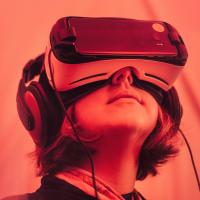The Future of Testing: VR and AR in Mobile Apps

If you watched any of the 2018 Winter Olympics, you may have seen a commercial inviting you to experience the games in virtual reality (VR). While VR is a new, cool, potentially life-transforming technology, it is still nascent. Early offerings in this medium are simply going to be a bit clunky. Currently, there is not much in VR that can be done for an event like the Olympics that doesn’t stretch the bounds of 360-degree video. But kudos to NBC for trying something new by giving VR a moment on the medal stand.
Why do I mention the Olympics? Well, if a company like NBC is willing to spend millions of dollars creating content for VR, and the biggest companies in tech are spending billions of dollars trying to solidify their VR and augmented reality (AR) platforms, that should tell you something. VR and AR are here to stay.
With the ability to experience VR on mobile devices and webVR on the horizon, the potential for VR to go mainstream is huge. Platforms like Apple’s ARKit and Google’s ARCore mean that AR and VR could be in the hands (and eyes) of more than three billion people by the end of 2020. Couple that with new hardware, like infrared cameras found on the iPhone X and Tango-enabled devices, and you have mobile devices that have amazing new capabilities.
So what does this mean for testing? For starters, the software development lifecycle processes that have been evolving over the past few decades will need to be revisited. What has worked in the past, especially for continuous integration, is not going to work going forward because testing—more specifically, test automation—is the linchpin in the CI process. A VR/AR product is an immersive experience. Testing for immersion, as subjective as that may be, takes human time and effort. There is just no way yet in VR and AR development to reclaim the time that UI automation has afforded us.
But this is a great thing for testers! It is going to force us out of our comfort zones (and out of our office chairs) to test these applications. New test environments, configurations, and interfaces will require testers to become versed in new technologies. With APIs and technology this cutting-edge, software testers have a great opportunity to know as much about the infrastructure of these projects as the developers do. This combined understanding between dev and test will probably be what makes teams successful in the early stages.
Just like the Olympic four-man bobsled team, each member on a dev team has a specific role to play. Where fractions of a second make the difference between silver and gold medals, a similar comparison can be drawn for testers on current teams or new AR/VR teams. Educating yourself as a tester on new AR/VR hardware, platforms, APIs, SDKs, and production tools may be the difference between your team failing to medal or winning the gold.
BJ Aberle is presenting the session AR and VR for Mobile Apps: Are You Ready to Test? at the STAREAST 2018 conference, April 29–May 4 in Orlando, FL.

